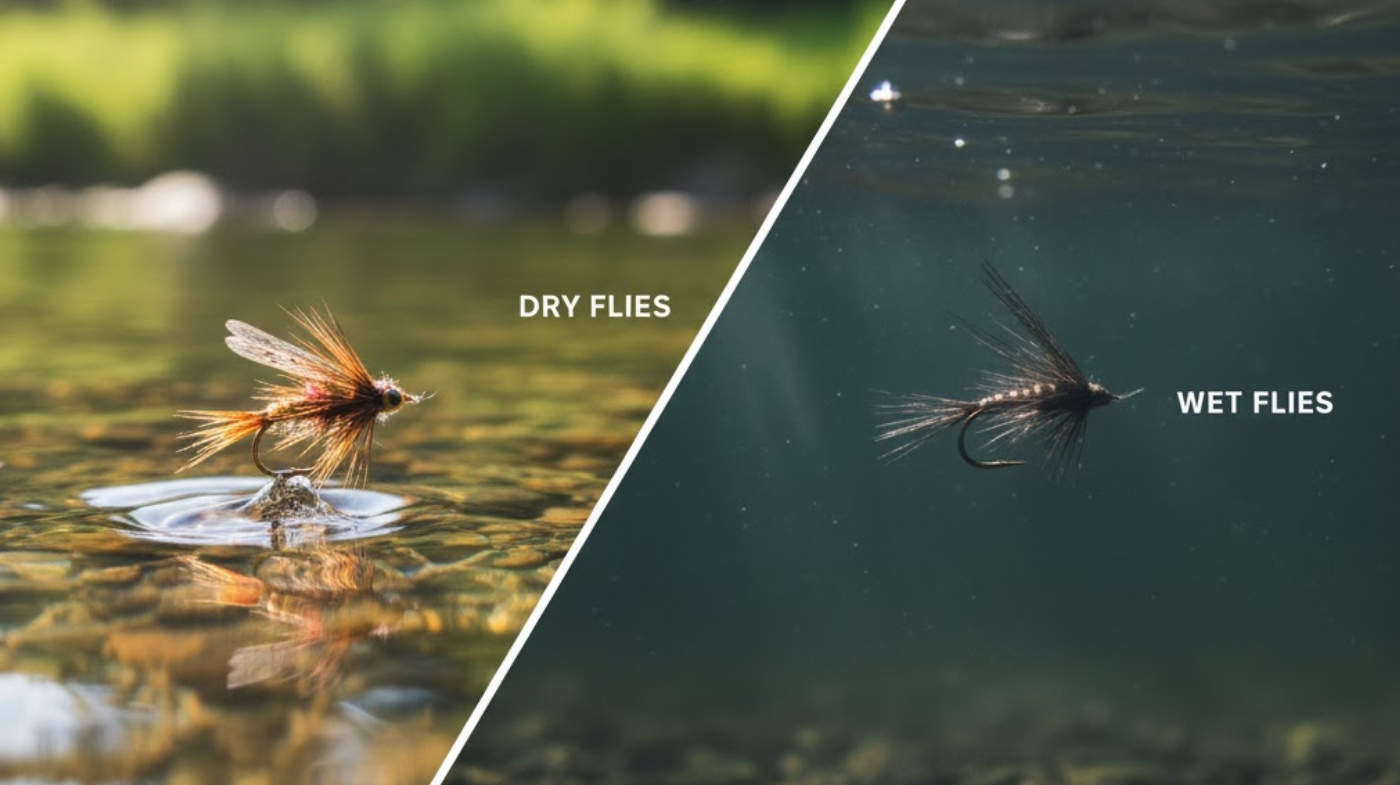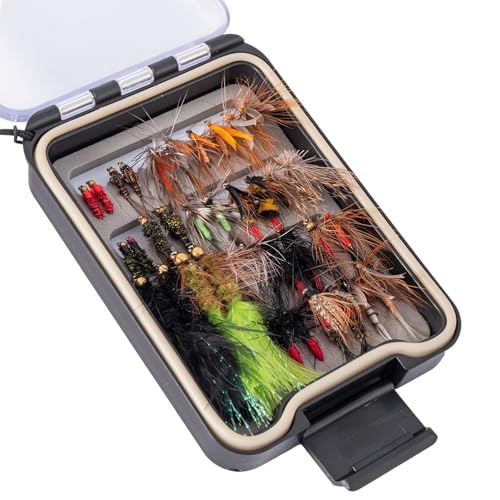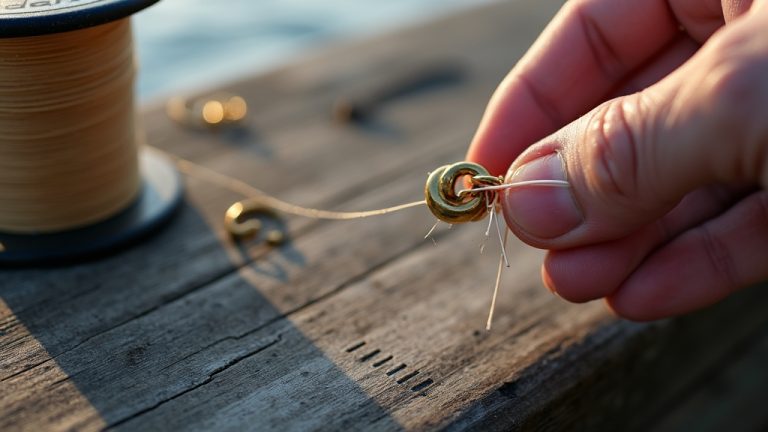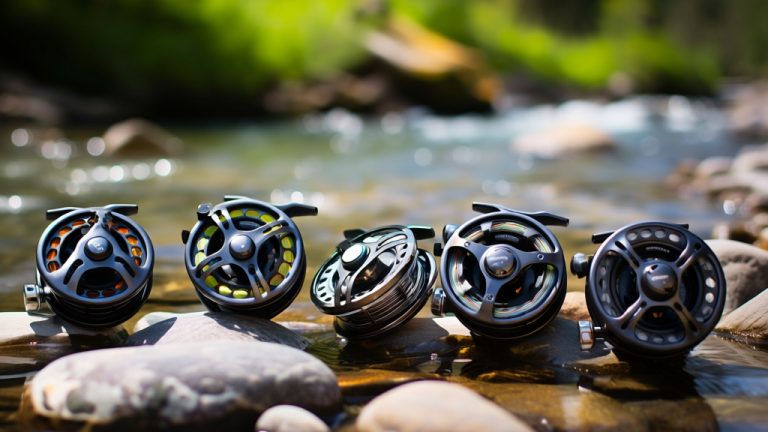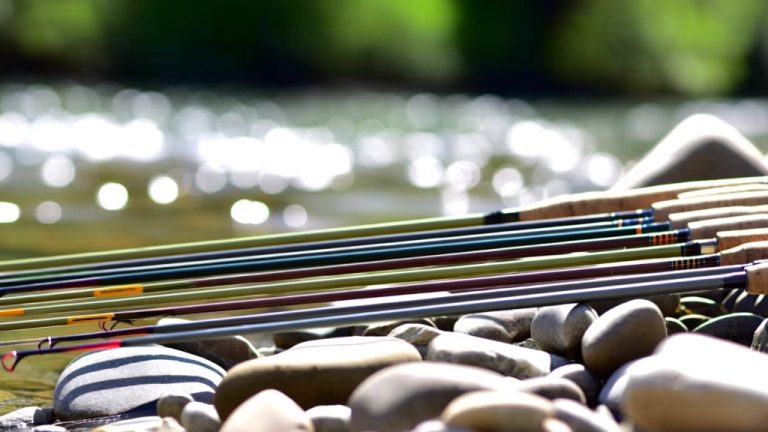Wet Flies vs Dry Flies: Primary Differences Explained
You’ll use dry flies to mimic insects resting on the water surface, requiring lighter hooks and buoyant materials like stiff hackle for delicate, drag-free presentation in clear, calm water.
Wet flies imitate underwater stages with heavier hooks, weighted components, and softer materials, thriving in turbulent or murky conditions.
Casting, line control, and presentation tactics differ. Dry flies demand precise, tight loops; wets benefit from longer, looser casts and upstream mends. Understanding these distinctions sharpens your fly choice and strategy for success.
- You can get excited about the premium items
- The 64 pcs flies kit includes Mayfly dries, Streamers, Leeches, Wet Flies, Terrestrials,…
- Please refer to the pictures for the detailed fly patterns and sizes
- Good Variety: Excellent selection of 18 popular flies pattern with great value, a must-have starter…
- Trusted Effective Flies: This assortment flies kit are picked and tied by fly fishing professionals…
- More choices for fishing: Our 36 pcs flies kit come in a variety of colors and sizes including…
Key Takeaways
- Dry flies float on the water surface, mimicking adult insects and requiring delicate, drag-free presentation.
- Wet flies sink below the surface, imitating nymphs or larvae, effective in turbulent or murky water conditions.
- Dry flies use lightweight hooks and buoyant materials like stiff hackle and foam for floatation.
- Wet flies incorporate heavier hooks and weighted materials to aid sinking and underwater movement.
- Combining dry and wet flies allows anglers to target both surface and subsurface feeding fish simultaneously.
A Quick Comparison of Wet and Dry Flies
| Feature | Wet Flies | Dry Flies |
|---|---|---|
| Water Position | Sink below the surface to imitate nymphs and larvae. | Float on the water surface to mimic adult insects. |
| Hook Weight | Use heavier hooks (1x–2x heavy) to help them sink naturally. | Use lightweight, fine-wire hooks to ensure buoyancy. |
| Material Type | Tied with softer feathers, lead wire, or tungsten beads for realistic movement underwater. | Made from stiff hackle, foam, or deer hair to keep them floating. |
| Ideal Conditions | Perform best in turbulent, murky, or deep water. | Excel in calm, clear water during visible insect hatches. |
| Casting Style | Involves longer, looser casts with upstream mending to simulate swimming prey. | Requires precise, tight loops for drag-free surface drift. |
| Strike Detection | Relies on tactile feedback and line tension to sense bites. | Depends on visual observation of surface strikes. |
| Skill Requirement | Easier for beginners due to forgiving presentation. | Demands greater accuracy and finesse in casting and drift control. |
| Seasonal Use | Best in early spring and cool conditions before surface hatches. | More effective in late spring and summer when hatches peak. |
| Fish Targeting | Targets subsurface feeders and nymph-eating trout. | Targets surface-feeding trout and rising fish. |
| Combination Setup | Can be paired with a dry fly in a dual-rig system to cover multiple depths. | Acts as both an attractor and strike indicator in combination rigs. |
Differences in Fly Types and Presentation
Although both wet and dry flies serve to imitate aquatic insects, they differ fundamentally in their target water column and presentation techniques.
You fish wet flies below the surface, targeting nymphs, larvae, and small baitfish by imparting movement like stripping or swinging to mimic natural underwater motion. This method often requires active manipulation to effectively imitate swimming prey and reflects the hook-centric techniques that define angling.
Dry flies, however, sit on the water surface, imitating adult or emerging insects and require a delicate, drag-free drift to appear naturally resting.
Success with dry flies hinges on avoiding unnatural disturbances, often achieved through dead drift and line mending, especially when fish feed visibly on surface insects.
Wet flies excel in murky or turbulent water and low-light conditions, while dry flies perform best in clear, calm water during insect hatches.
Hook and Material Characteristics
You’ll notice that wet fly hooks are generally heavier. This added weight helps the fly sink and maintain its position underwater. This principle aligns with how Maui Jim’s lens technology emphasizes specialized features for specific environments.
On the other hand, dry fly hooks are made with fine wire, which is designed to maximize buoyancy. Dry fly hooks also come in various shank lengths, allowing for better matching of natural insect proportions.
Now, let’s talk about materials. When it comes to dry flies, stiffer hackle is often preferred, while wets typically use softer, sometimes weighted components. This choice directly influences how the fly floats or moves in the water.
Hook Weight Differences
When selecting hooks for wet and dry flies, understanding the differences in wire gauge and weight is essential. These factors directly impact fly performance in water. Choosing the correct hook also depends on the specific fishing conditions you expect to encounter.
Dry fly hooks use thin wire gauges to minimize weight, ensuring superior floatation and delicate surface drift. In contrast, wet fly hooks employ heavier wire gauges, often 1x or 2x heavy, to add durability and promote sinking.
This increased hook weight enhances penetration but reduces buoyancy, which is critical for wet flies needing natural underwater movement. The choice of hook material and alloy content also plays a key role in providing strength and flexibility necessary for different fishing conditions.
Size and shape also vary: dry flies favor smaller, lightweight hooks (sizes 18–10) with standard shanks. Wet flies use larger, heavier, curved or long-shanked hooks to support added weight and optimize swimming action. The presentation and alignment of the hook can also influence effectiveness, similar to how certain knots maintain hook straightness.
Proper hook weight balances fly stability and natural behavior, directly influencing casting, presentation, and fish attraction.
Material Buoyancy Properties
Because material buoyancy directly influences fly performance, understanding the properties of both hook and tying materials is crucial for effective fly selection.
Dry flies rely on buoyant components like foam, stiff hackle barbules, and semi-hollow deer or elk hair. These materials trap air and shed water efficiently, maintaining flotation. Proper buoyancy prevents flies from sinking and drowning, which is essential for dry fly effectiveness.
Foam’s closed-cell structure ensures consistent buoyancy, while over-wrapped hackle enhances air retention.
Conversely, wet flies incorporate heavier hooks and materials such as tungsten beads, lead wire, and dense dubbing. These elements increase sink rate and achieve natural subsurface drift.
Soft, less rigid hackles enable subtle motion without buoyancy. Material surface properties also matter: dry fly hairs repel water to sustain trapped air, while wet fly fibers absorb water or are weighted for immersion.
Hackle and Wing Styles
Material buoyancy sets the foundation for how flies interact with water, but the hackle and wing styles ultimately define their presentation and effectiveness in mimicking insect behavior. Choosing the right tippet material is also crucial to maintain a natural surface tension and avoid spooking fish with an overly visible line, thereby enhancing the dry fly fishing effectiveness. Additionally, the angler’s choice of eyewear with proper UV protection can reduce glare and improve visibility on the water.
Dry flies use stiffer, uniform hackle fibers, typically from rooster necks, to maintain an upright posture on the surface. These fibers are about 1.5 times the hook gap. Their wings, often made from rigid elk hair or feathers, extend the length of the hook shank, aiding flotation and natural silhouette.
In contrast, wet flies employ softer, more pliant hen hackles that drape naturally underwater, also sized around 1.5 to 2 times the hook gap. Their wings are subtler, composed of soft hen feathers or fur, designed to flow with currents and simulate lifelike underwater motion rather than surface support.
Casting Techniques for Wet and Dry Flies
When it comes to casting wet and dry flies, there are some important techniques to master. Each type of fly has its own unique presentation style, and getting a handle on different loop types and precise control is essential. You really want to pay attention to casting distance and accuracy here. Understanding how to properly tie fishing knots can also improve your casting efficiency and knot strength.
For dry flies, it’s all about that pinpoint placement, while wet flies can benefit from a more strategic approach, like casting upstream or across the current. Additionally, dry fly fishing typically uses floating lines to keep the fly on the surface for a natural presentation. It’s interesting how each method has its nuances, right?
And let’s not forget about line management! For dry flies, you’ll want to keep some slack in your line, which helps with the natural drift. On the other hand, wet flies require tighter control to help you notice any immediate strikes.
Loop Types and Control
When mastering casting techniques for wet and dry flies, understanding the distinct loop types and their control is essential to achieving natural fly presentation and ideal movement.
For dry flies, the non-slip loop knot and improved clinch knot are preferred due to their strength and ability to maintain delicate, drag-free surface presentation. Patterns like the Elk Hair Caddis are popular dry flies because they float well and withstand various water conditions, enhancing surface presentation. Choosing rods with a lightweight design can further improve your delicate presentations.
Controlling loop size is vital; tighter loops enhance accuracy and minimize splash, while longer loops allow more fly movement.
With wet flies, the double Turle knot and non-slip loop knot facilitate free swinging and natural underwater action. Loop size directly influences swing depth and movement, with larger loops enabling deeper, unrestricted swings.
Effective loop control prevents fly tangling and maintains realistic action, optimizing your presentation whether floating a dry fly or swinging a wet pattern in currents. Using CDC wing flies as trailers behind visible dry flies can improve buoyancy and realism, especially in calm water conditions.
Casting Distance and Accuracy
Although casting techniques for wet and dry flies share some principles, the distinct physical characteristics of each fly type dictate different approaches to distance and accuracy.
With dry flies, you rely on false casting to build line momentum, achieving effective casts between 20-40 feet. Precision is paramount; tight, flattened loops enable delicate presentations, pivotal for mimicking surface insects and avoiding spooking fish. Dry fly is the lightest lure, designed to float on the surface, which demands more precise placement. Using fluorocarbon leader can enhance stealth and reduce fish spooking during these delicate presentations.
Roll casts limit distance but excel in confined spaces. Wet flies, being heavier, allow looser, open loops and longer casts beyond 40 feet, favoring access to distant feeding zones.
Roll casts with wet flies benefit from softer rod actions for effortless 35-40 foot casts. While wet fly casting prioritizes controlled presentations beneath the surface, you balance distance and accuracy to maintain drag and detect strikes effectively.
Line Management Strategies
Since effective line management directly influences your fly’s presentation, mastering distinct techniques for wet and dry flies is essential. For wet flies, you’ll focus on controlling line tension to manage depth and create natural swim actions.
Many traditional wet flies, such as high country spiders and partridge in orange, are designed to sink and provide lifelike animation, making soft tackle wet flies highly effective for probing fish when surface activity is low. Wearing appropriate footwear inside waders can enhance your mobility and stability while managing the line in varying water conditions.
Employ upstream mends and rod tipping to maintain slack and simulate insect behavior. Dry fly fishing demands precise surface control to ensure a drag-free drift and heightened sensitivity to subtle strikes.
Key line management strategies include:
- Mending wet fly lines upstream to allow natural sinking and swinging motions.
- Keeping excess line off the water to improve strike detection and reduce drag.
- Using rod tip control to adjust tension and maintain fly contact in wet fly fishing.
- Executing meticulous surface mends for dry flies to achieve a natural float and stealthy presentation.
Master these to optimize your fly’s effectiveness.
Understanding Fish Behavior and Feeding Zones
Because fish aim to conserve energy while maximizing food intake, they strategically position themselves in flow zones where current velocity is slow to moderate. This often occurs near structures like rocks or drop-offs that create calm holding lies. Fish seek locations with abundant food, safety, and low energy expenditure, often choosing prime lies such as undercut banks or behind boulders.
Feeding zones concentrate along drift lines, seams, and edges where prey aggregates. You’ll find trout holding on downstream sides of structures to intercept food with minimal effort. They may shift positions during insect hatches or varying light conditions.
| Zone Type | Flow Velocity | Fish Behavior |
|---|---|---|
| Holding Lies | Slow to moderate | Energy conservation near structures |
| Drift Lines | Moderate | Intercepting subsurface prey |
| Surface Zones | Calm | Targeting rising insects |
| Pool Bottoms | Slow | Refuge, low feeding activity |
| Margins/Edged | Variable | Ambush or opportunistic feeding |
Understanding these zones enhances your fly selection and presentation tactics.
Strike Detection and Hook Setting Strategies
When you fish with dry or wet flies, accurately detecting strikes and executing precise hook sets demand keen observation and reflexes tailored to each method.
Dry flies require sharp visual cues. Watch for surface breaks or float deviations signaling a strike. Their construction with buoyant materials helps them remain visible on the water surface. Choosing the correct tippet diameter can enhance the presentation by making the fly appear more natural.
Wet flies rely more on tactile feedback, sensing subtle line twitches or hesitations. Your hook-setting technique must match these nuances.
- For dry flies, set the hook quickly but gently as fish release surface insects fast.
- Maintain a loose line until the strike to avoid spooking fish.
- With wet flies, react swiftly to subtle line movements, using smooth lifts or slight strip strikes.
- Avoid over-aggressive sets to prevent fly loss or tippet breakage.
Learning Curve and Skill Requirements
Although both dry and wet fly fishing demand specialized skills, you’ll find that dry flies require a steeper learning curve due to the necessity for delicate casting, precise presentation, and acute visual strike detection.
You must master roll casts and mending to maintain drag-free dead drifts on the surface, reading currents and insect activity accurately. Beginners often benefit from learning basic casting techniques to improve accuracy and line control early in their practice.
Conversely, wet flies allow more leniency in casting, as their subsurface presentation accommodates varied casting styles and slower sink rates.
Your tactile sensitivity and rod tip feel become paramount underwater to detect subtle takes.
Dry fly proficiency demands longer practice to refine eye training for rises and line control, while wet fly skills develop tactile awareness and underwater reading gradually.
Both require insect knowledge, but dry fly timing aligns tightly with surface hatches, increasing complexity.
Additionally, understanding the insect life stages and selecting flies that match these stages can significantly improve your success with both dry and wet flies.
Environmental Conditions and Fly Selection
Selecting the right fly hinges considerably on environmental conditions, as water clarity, surface activity, current speed, and weather directly affect both fish behavior and fly effectiveness. You must evaluate these factors to optimize your fly choice.
- Water Clarity & Surface Conditions: Use dry flies in clear, calm water for natural drift. Switch to wet flies in turbulent or murky water where visibility is limited. Additionally, anglers should consider the insect hatch stage, as dry flies mimic adult or emergent insects visible on the surface, while wet flies imitate subsurface stages.
- Temperature & Light: Dry flies excel during warm, sunny insect hatch periods. Wet flies work year-round, especially in early spring or cool conditions before hatches. Recognizing the hatch timing tied to environmental cues helps anglers decide when to switch between dry and wet patterns.
- Fish Feeding Behavior: Target surface feeders with dry flies. Employ wet flies for subsurface or deeper feeding fish, especially when surface activity is low. Observing fish rise forms—such as full mouth or porpoising—can indicate whether to present a dry fly or an emerger pattern below the surface.
- Current Speed: Dry flies perform best in slow currents. Wet flies adapt well to faster, turbulent flows, enabling multiple presentation techniques. Positioning and presentation techniques, such as reach casts and drag-free drifts, play an important role in dry fly effectiveness in varying currents.
Mastering these environmental cues refines your fly selection and increases fishing success.
Combining Wet and Dry Flies for Effective Fishing
Combining wet and dry flies in a single rig enhances your fishing versatility by targeting multiple feeding zones simultaneously. This approach increases chances of catching more trout by providing multiple options for the fish to choose from.
Attach the dry fly at the leader’s end and tie the wet fly 18–24 inches behind, ensuring adequate spacing to prevent tangles and allow independent movement. The dry fly on the surface attracts cautious fish and serves as a strike indicator, while the wet fly explores subsurface feeding zones, mimicking nymphs or emergers.
This dual rig covers a broader water column, maximizing strike opportunities and increasing catch potential by catering to varied fish preferences. Use weighted wet flies to reach desired depths and maintain buoyancy balance with dry flies. Employ this setup in complex currents or during insect hatches to adapt dynamically and present natural, effective imitations across feeding layers.
Frequently Asked Questions
How Should I Store Wet and Dry Flies to Maintain Their Condition?
You should store dry flies in compartmentalized boxes that prevent hackle compression and allow airflow to avoid moisture buildup.
Keep them organized by species or hatch type and away from direct sunlight.
For wet flies, use fixed-position boxes with foam liners to secure them, ensuring they dry before storage to prevent rust and mold.
Always store dry and wet flies separately and choose boxes sized appropriately to prevent tangling or damage.
Can Wet and Dry Flies Be Tied Using the Same Tying Tools?
Yes, you can tie wet and dry flies using the same set of tying tools.
Essential tools like a quality vise, scissors, bobbins, and whip finish tool work universally.
While materials differ, wet flies need weighted components and dry flies require lighter hackle, your core tools remain consistent.
Investing in a versatile rotary vise and sharp scissors improves precision across patterns.
Minor handling adjustments might be necessary, but no separate toolsets are needed.
What Are the Common Mistakes Beginners Make With Wet and Dry Flies?
Did you know over 60% of beginners struggle with drag caused by poor casting angles?
You often let dry flies skate unnaturally, breaking the insect illusion.
With wet flies, you might clamp down too hard after a strike, snapping tippets.
Common errors include excessive false casting, incorrect hook sets, and failing to read currents properly.
Master precise rod stops, casting angles, and line control to avoid these pitfalls and improve your fly presentation.
Are There Seasonal Differences in Selecting Wet Versus Dry Flies?
Yes, you need to adjust your fly selection seasonally.
In early spring, colder water and fewer surface hatches mean trout feed below the surface, so wet flies work best.
As temperatures rise and insect hatches increase during late spring and summer, trout feed on surface insects, making dry flies more effective.
Monitoring water temperature, hatch activity, and fish behavior helps you choose between wet and dry flies for ideal results throughout the year.
How Do Fly Sizes Affect the Effectiveness of Wet and Dry Flies?
Fly size directly impacts your fly’s visibility, presentation, and fish response.
Larger flies improve detection in turbulent water but risk spooking wary fish in clear conditions.
Smaller flies provide delicate, natural drifts essential for dry fly success during hatches.
For wet flies, moderate to larger sizes aid sinking and mimic subsurface prey effectively.
Adjust your tippet and leader to maintain lifelike movement, tailoring fly size to current water clarity, fish behavior, and feeding depth.
Turn Knowledge into Action: Try Both Fly Styles Today
Mastering both wet and dry flies markedly boosts your angling success, as studies show anglers using combined techniques increase catch rates by up to 40%. By understanding the distinct presentation, materials, and casting methods, you’ll better match fish behavior and feeding zones.
With precise strike detection and refined hook-setting strategies, you’ll confidently adapt to varying environmental conditions. Embracing this technical knowledge elevates your skill, making you a more effective and versatile fly fisherman.
- 【Effective Flies】-30/50/60/100/168 pieces flies cover greatest flies of all time.Such as Wolly…
- 【Target Fish】For Catching Trout,Grayling and Salmon,Steelhead,Pike,Carp.
- 【Waterproof Fly Box】The box measures 13.6*8.6*3.6cm(5.2 x 3.5 x 1.4 inch), Oranising your flies…
- Professionally Picked Assortment – This foundational package, meticulously selected by fly fishing…
- Fish Approved Flies – Get your hands on the “tried-and-true”, “fish-approved” flies that…
- Match the Hatch – With the absolute beginner fly fisherman in mind, we’ve made this assortment…
Last update on 2025-12-10 / Affiliate links / Images from Amazon Product Advertising API

